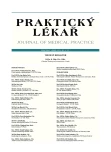Pulmonary embolism and its diagnostic problems
Authors:
T. Olos 1,2; F. Burša 3
Authors‘ workplace:
Klinika dětského lékařství, Oddělení pediatrické resuscitační a intenzivní péče, Fakultní nemocnice Ostrava, Přednosta: doc. MUDr. Michal Hladík, PhD.
1; Letecká záchranná služba, územní středisko záchranné služby, Ostrava, Ředitel: MUDr. Roman Gřegoř
2; Anesteziologicko - resuscitační klinika, Fakultní nemocnice Ostrava, Přednosta: MUDr. Jan Jahoda
3
Published in:
Prakt. Lék. 2011; 91(11): 669-673
Category:
Diagnostis
Overview
Pulmonary embolism is the most serious clinical sign of thromboembolism. Diagnosis of pulmonary embolism represents a very complicated medicinal problem even nowadays. Clinical suspicion of pulmonary embolism needs to be confirmated by modern diagnostic tools. According to recent studies, the wide use of CT angiography during pulmonary embolism diagnosis has led to “overdiagnosis” of this disease and a large number of patients proceed with the unnecessary risk of anticoagulation treatment.
Keywords:
pulmonary embolism, thromboembolism, CTA-angiopulmography.
Sources
1. Donato, A.A., Knoche, S., Santora, J. et al. Clinical outcomes in patients with isolated subsegmental pulmonary emboli diagnosis by multidetector CT pulmonary angiography. Thromb. Res. 2010, 126(4), p. 266-270.
2. Ferrari, E., Baudouy, M., Cerboni, P. et al. Clinical epidemiology of venous thrombo-embolic disease. Results of a French multicentre registry. Eur. Heart. J. 1997, 18, p. 685–691.
3. Firment, J., Studená, A. a kol. Anesteziológia a intenzívna medicína. UPJŠ Košice, 2004, s. 188.
4. Kaczynska, A., Pelsers, M.M., Bochowitz, A. et al. Plasma heart type fatty acid binding protein in superior to troponin and myoglobin for rapid risk stratification in acute pulmonary embolism. Clin. Chim. Acta 2006, 371(1-2), p. 117-123.
5. Kostrubiecz, M., Pruszczyk, P., Bochowitz, A. et al. Biomarker – based risk assesment model in acute pulmonary embolism. Eur. Heart J. 2005, 26, p. 2166-2172.
6. Kulíšek, D. Elektrokardiografické zmeny pri pľúcnej tromboembólií. In: Mazuch, J, Kukura, A, a kol. Pľúcna tromboembolia v klinickej praxi. Martin, Osveta, 1978, s. 96-104.
7. Lang, O, Kamínek, M. Radionuklidové metody v diagnostice plicní embolie. Kardiol. Prax. 4, 2006, 4, s. 235-239.
8. Mazuch, J. Súčasný stav diagnostiky a liečby masívnej pľúcnej tromboembólie. Vask. med. 2010, 2(1), s. 16-20.
9. Nakos, G., Kitsiouli, E.I., Lekka, M.E. Bronchoalveolar lavage alterations in pulmonary embolism. Am. J. Resp. Crit. Care Med. 1998, 158, p. 1504-1510.
10. Slovenská kardiologická spoločnosť. Odporúčania pre diagnostiku a manažment pacientov s akútnou pľúcnou embóliou. Cardiol, 2009, 18(3), s. 117–146.
11. Panteghini, M., Cuccia, C., Pagani, F. et al. Cardiac troponin I elevation in serum as a marker of right ventricular involvement and disease severity in acute pulmonary embolism. Eur. Heart J. 2001, Suppl. 22, p. 620.
12. Remy-Jardin, M., Remy, J. Deschildre, F. et al. Diagnosis of pulmonary embolism with spiral CT: comparison with pulmonary angiography and scintigraphy. Radiology 200, 1996, 7, p. 699-706.
13. Spencer, F.A., Emery, C., Joffe, S.W. et al. Incidence rates, clinical profile, and outcome of patients with venous thromboembolism: the Worcester VTE Study. J. Thromb. Thrombolysis 2009, 28(4), p. 401-409.
14. Stein, P.D., Foxler, S.E., Goodman, L.R. et al. PIOPED II Investigators. Multidetector computed tomography for acute pulmonary embolism. N. Engl. J. Med. 2006, 354(22), p. 2317-2327.
15. Torbicki, A, Van Beek, E.J.R., Charbonier, B. et al. Odporúčané postupy v diagnostike a manažmente akútnej pľúcnej embólie. (Koordinačná správa výboru pre pľúcnu embóliu Európskej kardiologickej spoločnosti.) Cardiol. 10 2001, 4, s. 175-216.
16. Vítovec, M. Ultrazvukové vyšetřování v diagnostice plicní embolie. In: Widimský, J, Malý, J, a kol. Akutní plicní embolie a žilní trombóza. Praha, Triton, 2002, s. 66-71.
17. Widimský, J., Malý, J. et al. Akutní plicní embolie a žilní trombóza. Praha, Triton, 2002, s. 303.
18. Wiener RS, Schwartz LM, Woloshin S. Time trends in pulmonary embolism in the United States evidence of overdiagnosis. Arch. Intern. Med, 2011, 171(9), p. 831-837.
19. Van Strijen, M.J.L, De Monye, W., Kieft, G.J. et al. Accuracy of single-detector spiral CT in the diagnosis of pulmonary embolism: a prospective multicenter cohort study of consecutive patients with abnormal perfusion scintigraphy. J. Thromb. Haemost, 2005, 3, p. 17-25.
20. Oudwerk, M., van Beek, E.J., Weilopolski, P. et al. Comparison of contrast enhanced magnetic resonance angiography and conventional pulmonary angiography for diagnosis of pulmonary embolism: a prospective study. Lancet 2002, 338, p. 1643-1647.
Labels
General practitioner for children and adolescents General practitioner for adultsArticle was published in
General Practitioner

2011 Issue 11
- What Effect Can Be Expected from Limosilactobacillus reuteri in Mucositis and Peri-Implantitis?
- Memantine Eases Daily Life for Patients and Caregivers
- Metamizole vs. Tramadol in Postoperative Analgesia
- Advances in the Treatment of Myasthenia Gravis on the Horizon
Most read in this issue
- Faecal calprotectin
- Probiotics from the view of the general practitioner – clinical indications for the use of probiotics, results a questionnaire study among general practitioners
- Pulmonary embolism and its diagnostic problems
- Actinic keratosis: the facts about biological behaviour and clinico-pathological aspects of the disease from the view of pathologist
